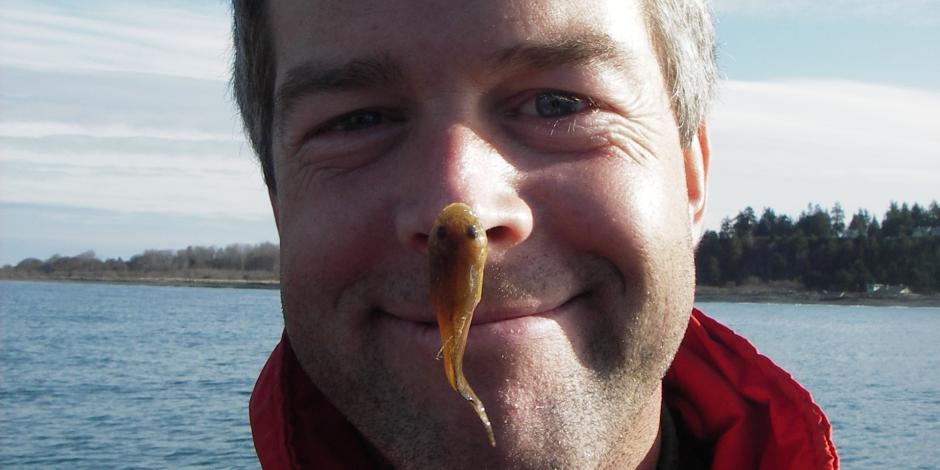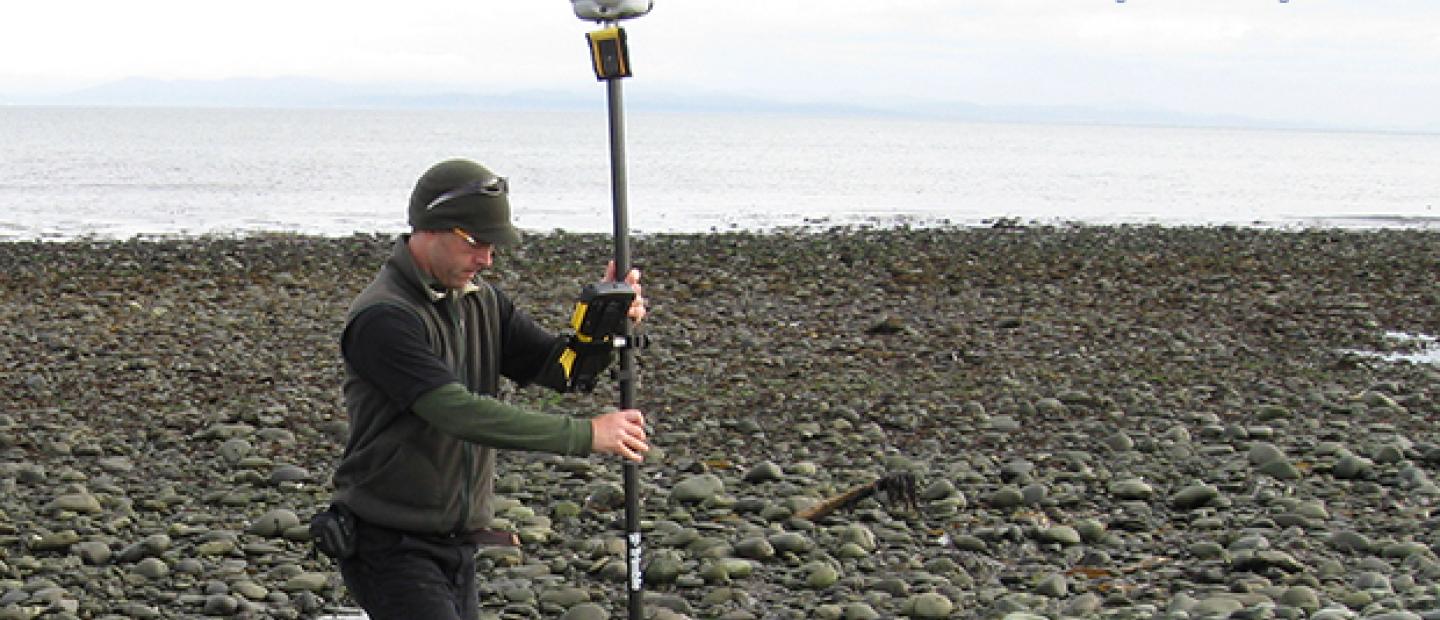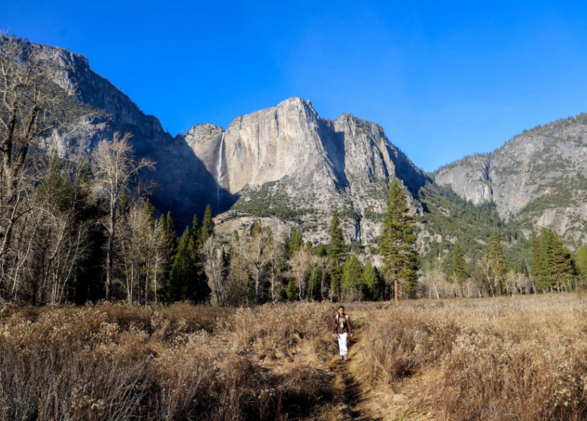Talking Danger with Ian Miller: How to Communicate Science

As a young boy, Ian Miller would take walks with his grandfather on the beaches of Delaware Bay. This was back in the late 1970s and early 1980s, and at Ian’s age, he didn’t immediately understand why his grandfather spent so much time picking up trash and cleaning up the coastline.
“I remember being interested in what he was doing and asking him why,” says Ian.
His grandfather explained pollution and littering and what it meant to take care of the natural world. “That’s one moment that gave me a piece of my current marine conservation ethic.”
Ian would go on to become a coastal hazards specialist at the University of Washington’s Washington Sea Grant. Before joining Washington Sea Grant, and some years after his beach walks, Ian became a NatureBridge educator.
After his father received a Navy posting in Portland, Oregon, Ian lived in Vancouver, Washington and earned his undergraduate degree at Western Washington University in nearby Bellingham. From there, his travels took him across the country to the Northeast. This, ironically, is where he first heard about NatureBridge, (then Olympic Park Institute, or OPI).
“I had an internship with the Boston University Sargent Center camp, where the emphasis was on training people how to work with groups in the outdoors,” says Ian. “When I was done, I was ready to move back to Washington and was at a conference at Lake Winnipesaukee in New Hampshire when someone told me about an educator position at some place called OPI. Somehow, it was the first I’d heard of it.”
Ian applied and the job is what eventually brought him back to Washington, where he would stay for more than 20 years at NatureBridge and beyond. His time as an educator and eventually education director at NatureBridge solidified his values and gave him tools for the next steps in his career.
“One thing I’ve come to realize living in Port Angeles is just how important NatureBridge is to the community here,” he says. “At least in my case and I believe many others, it draws people in, develops them professionally, and then they stay and build a life here. It plays this really important community development role that I think is largely unrecognized, or at least not lauded enough.”
As a coastal hazards specialist, Ian has spent many hours working with communities to warn them about the dangers of climate change and its myriad effects. It’s a position that leverages both his science background — Ian completed his graduate work at UC Santa Cruz on ocean sciences — and his education background at places like NatureBridge and Boston University.
“A lot of what we are engaged in is applying science to community needs associated with planning and preparing for hazards. That's all about figuring out how to translate science; it's all about community engagement,” he says.
Engaging with students as a NatureBridge educator and engaging communities about coastal hazards can sometimes require strikingly similar communication tools. As a graduate student at UC Santa Cruz, Ian took a course on how to be a teaching assistant. Part of the course was teaching an ocean science topic to the class and the professor.
“I chose to focus my lesson on plankton, leveraging things that I would have done with kids in a variety of programs that I participated in, including NatureBridge. And people in that class were blown away by what I chose to do. To me, it was normal because I've done it so many times with kids, but they were just astonished by the way I presented the information and conducted the lesson. I think that kind of speaks to the value of a program like NatureBridge’s.”
One thing I’ve come to realize living in Port Angeles is just how important NatureBridge is to the community here. At least in my case and I believe many others, it draws people in, develops them professionally, and then they stay and build a life here. It plays this really important community development role that I think is largely unrecognized, or at least not lauded enough.Ian Miller
In the field of science, there is a documented history of scientists not communicating well with non-scientists. There are countless blog posts, articles and headlines about this topic: Scientists need to become better communicators, but it’s hard to measure whether training works, Why Can’t Scientists Talk Like Regular Humans? and Why scientists are losing the fight to communicate science to the public are just a few examples.
Why is it so difficult to communicate science?
“Well, I mean, part of me feels like it's not, right?” Ian laughs. “I guess part of that is because when you are developing and communicating a scientific concept, oftentimes, your first audience is other scientists, and there's a reason for that: that’s the core way of evaluating and assessing the validity of a conclusion or concept. It’s the retranslation of that concept once that part has run its course that’s been given the short shrift.”
Ian is specifically tasked with retranslation in his position at Washington Sea Grant. He interfaces with non-scientists often, engaging with people on topics of sea level rise, climate change, erosion, ecology and tsunamis. It requires him to assess his audience’s knowledge level in a short period of time — minutes or hours rather than days or weeks — and base his dialogue off of that assessment.
“That’s one challenge; not having a lot of time to gauge where people are,” he says. “But people understand scientific concepts more than we give them credit for. That’s what I’ve found.”
When prompted about a specific topic that scientists have overcomplicated but that people generally understand, Ian offered up “the thermosteric component” as it relates to sea level rise.
“It basically means water expanding as it heats up,” he says “Actually, it’s easy to explain because most of us have a close relationship to that process due to our hot water tanks. I talk about the overflow valve on our hot water tanks; if we didn’t have it, we'd have hot water pouring onto our floors every single day because hot water causes expansion. It's just language barriers. I don't fault scientists at all for selecting terms that help to quickly communicate things, but it's important to recognize where those barriers occur when you're communicating with other audiences that aren't trained in the use of those terms.”

Ian’s list of accomplishments since returning to Washington to work for NatureBridge in February of 1997 is extensive. He has published 16 research papers on the Elwha dam removal, developed Washington State’s most recent sea level rise assessment, and has partnered to create comprehensive climate change vulnerability assessments for the Jamestown S’Klallam Tribe.
“I'm constantly thinking back to the cauldron of communication that is outdoor environmental science because that’s exactly what I’m doing week after week. Sometimes with children, oftentimes with adults, but in the end, it doesn't matter; it's the same lessons. I'm applying those lessons all the time.”
Applying those lessons with people directly impacted by climate change and other hazards means that someone else may see what Ian is doing and — just as Ian asked his grandfather why he cleaned up the coastline — ask Ian why he’s trying to save theirs.

